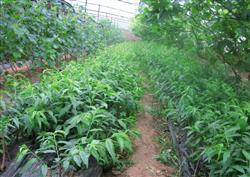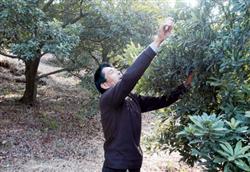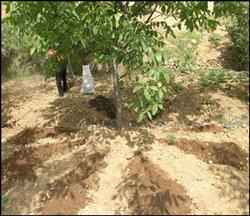Picture of planting technology of peach in trousers

Honey peach belongs to a kind of spherical edible fruit, which has the functions of beautifying skin, clearing stomach, moistening lung, expectorant and so on. Its protein content is twice as high as that of apples and grapes and seven times higher than that of pears. It contains three times more iron than apples and five times more than pears. It is known as the queen of fruits. There are many plants in our country. Rich in a variety of vitamins, of which vitamin C is the highest. The following introduction of peach planting techniques for reference: first, seedling selection: according to the soil, climate, management level and local market situation, select good varieties with high yield and the right way of production and marketing, and make a good mix of early, middle and late ripening varieties. Second, the establishment and planting of the garden: select fine drainage, deep soil layer, PH 5.5-6.5 slightly acidic sandy soil or sand-gravel loam to dig large holes for planting; low hilly slopes should build terraces with a planting density of 4050 plants per mu and 60 plants per mu in mountainous areas. Third, apply sufficient base fertilizer: timely topdressing: base fertilizer advocates winter fertilizer and autumn application, mainly organic fertilizer, accounting for 60%-70% of the total amount of fertilizer applied in the whole year, generally applying stable fertilizer 2000kg per mu or 150 kg per mu of special fertilizer for fruit trees. the times, time and amount of topdressing vary according to varieties, tree ages, cultivation and management methods, growth and development periods and external conditions, generally giving priority to pre-bud fertilizer, strong fruit fertilizer and postharvest fertilizer. 4. Shaping and pruning techniques: (1) Tree shape and tree structure: the tree shape is a natural happy shape of three main branches. In the tree structure, the height of the adult tree is about 2.5 ~ 3m, the trunk height is 30cm ~ 40cm, there are 3 main branches, each occupying 120 °azimuth, each main branch is equipped with 1 ~ 2 secondary main branches, and the opening angle is about 75 °. (2) Tree culture: dry at 50-60 cm in the year of planting, and there are more than 3 strong buds in the plastic band under the cut. In the first year after planting, the new shoots with strong growth and good azimuth were selected and cultured as the main branches, and the other shoots could be thinned or twisted as auxiliary branches. In the second year after planting, the lateral strong branches were selected at the distance of 50-60 cm from the main stem, the opening angle was good, the secondary main branches were cultivated, and the large and small fruiting branches were cultured on the main branches and auxiliary main branches at the same time. (3) pruning: dormant period (winter) pruning. It can be carried out after falling leaves to before budding, and pruning adopts the combination of truncation and thinning, as well as measures such as long release, retraction, looping branches and so on. Fruit branch pruning: long fruit branch, about 1/3 of the branch length; middle fruit branch except sparse cut dense branch, generally not short; short fruit branch should retain 1 branch every 10 cm. The number of branches retained depends on site conditions, management level, tree age, tree potential and yield requirements. Pruning during the growing period mainly includes: re-pruning after anthesis, removing sprouting and wiping buds, thinning branches, twisting branches, coring, pulling branches, pruning, moving branches and other technical measures. Fifth, fruit management technology: the fruit setting rate of honey peach is high, so fruit thinning must be carried out and the amount of fruit retained must be controlled. Fruit thinning should be carried out in two times, from late April to early May and mid-late May respectively. Generally, there are 1 fruit in short fruit branch, 2 fruit in middle fruit branch and 3-5 fruit in long fruit branch. Spray the bag in time after setting the fruit. The harvest time of the fruit is determined according to the characteristics of the variety, and it is suitable to harvest 80% of the mature fruit. 6. prevention and control of diseases and insect pests: first of all, we should do a good job in clearing the garden in winter, remove diseased branches and leaves in time combined with winter pruning, whiten the trunk before and after the Beginning of Winter, and spray Baume 5-degree stone sulfur mixture before sprouting in early spring. in the growing period, brown rot, anthrax, scab, leaf shrinkage and other diseases should be prevented. The pests harmful to peach trees are aphids, pear heart borer, small green leafhopper, peach borer, stinging moth, military insects, mulberry scale and so on. Click to get more peach tree planting techniques click to get more fruit planting techniques
- Prev

How to prune bayberry trees during dormancy?
How to prune bayberry trees during dormancy? When is the dormancy period of bayberry trees? What are the ways to prune red bayberries? Please give an introduction to the general dormancy period of Chinese bayberry trees from late October to mid-November to mid-February to late March. The pruning methods of Chinese bayberry dormancy period include: removing sprouts, picking cores, pulling branches and supporting branches, ring cutting, girdling, and falling.
- Next

How to manage hickory trees in autumn?
How to manage hickory trees in autumn? Please introduce in detail that the main management of hickory trees in autumn are fertilization and pest control. Detailed methods can be referred to the following: 1. Fertilizing hickory trees purpose: pecans consume a lot of nutrients after fruit growth. Short branches and bare teeth that have differentiated next year need to have enough.
Related
- Moge, come on! The staff of the peasant association in the producing area of cantaloupe were frightened when the crowd gathered.
- Causes and Solutions of low Fruit setting rate of Apple
- Symptoms and control measures of passion fruit virus disease
- Fruit growing lesson: how do apple orchards keep high yields?
- Can you build orchards in the mountains? What are the pros and cons?
- How to manage the coloring period of Crisson grape?
- This paper introduces the processing technology of two kinds of fig products.
- How much is a month for retired teachers in rural areas by 2020?
- How can strawberry planting increase sugar content? We should pay attention to management in many aspects.
- What are the cultivation techniques on how to improve the yield of golden fruit?

